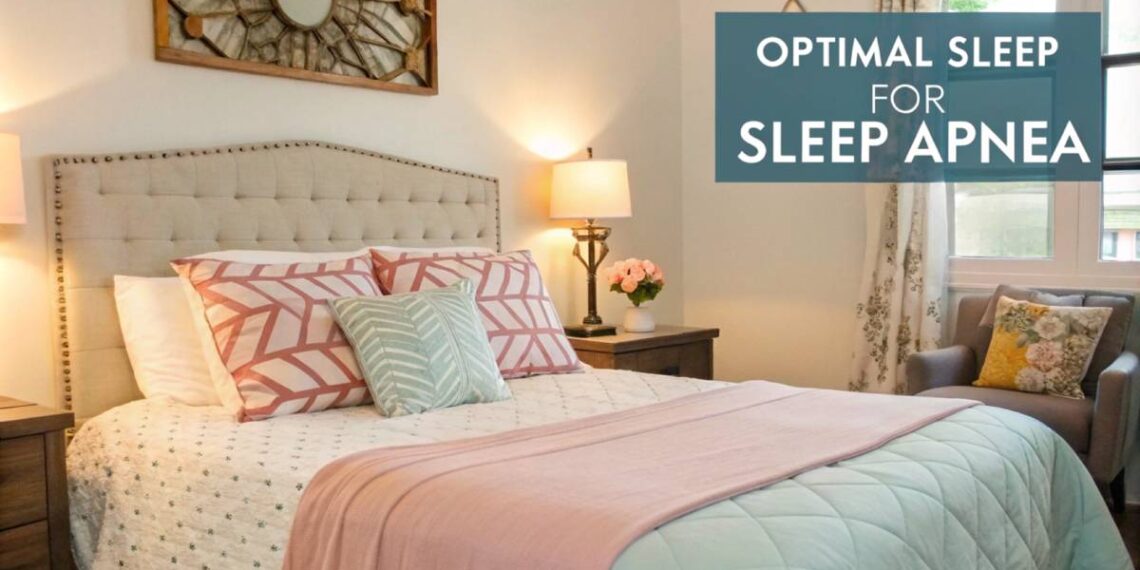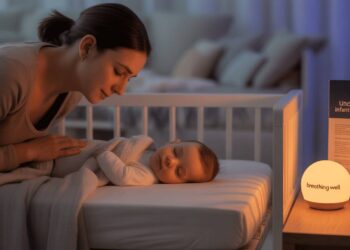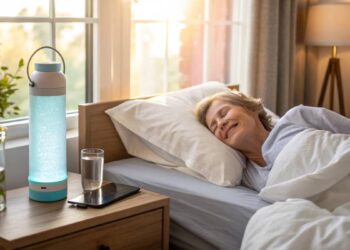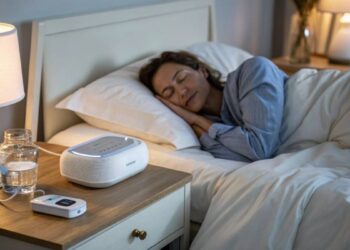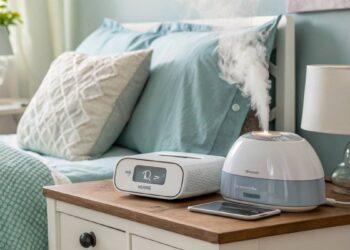Struggling with restless nights and disrupted sleep? You’re not alone. Sleep apnea affects millions, turning peaceful slumbers into nightly battles. But what if a simple change in how you position yourself could make all the difference? Dive into our comprehensive guide where we unravel the best sleep positions, smart pillow choices, and essential lifestyle tweaks that can transform your nights from troubled to tranquil. Say goodbye to snooze struggles and hello to rejuvenating rest!
Main Key Takeaways
- Optimal Sleep Positions: Side sleeping significantly reduces sleep apnea symptoms compared to back or stomach sleeping.
- Smart Pillow Choices: Wedge, contoured, and body pillows can enhance comfort and support proper airway alignment.
- Lifestyle Modifications: Weight management and avoiding alcohol or heavy meals before bed can drastically improve sleep quality.
- Understanding Sleep Apnea: Recognizing symptoms and seeking professional advice are crucial for effective management.
- Monitoring Sleep Quality: Utilizing gadgets and keeping a sleep journal can help track and improve sleep patterns.
Understanding Sleep Apnea
What is Sleep Apnea?
Sleep apnea’s that annoying sleep disorder where your breathing keeps pausing like an uncertain actor on stage. Imagine being stirred up from your slumber multiple times an hour because airways decide to play literal peekaboo. Oxygen? Yeah, your body’s supply gets compromised too. We’ve got types here: obstructive and central sleep apnea — each with its own quirks, kind of like cousins at a family reunion. Check out more on the assorted flavors of apnea in our article on the great sleep apnea showdown.
Folks dealing with sleep apnea often find themselves caught in a symphony of loud snores, unexpected chokes, and gasp-worthy awakenings. It doesn’t discriminate much but tends to hang out more with folks struggling with weight issues, people traipsing through their 40s, and post-menopausal women. A proper diagnosis often involves playing guinea pig in a sleep study, sometimes right from the comfort of your own home with a home sleep apnea test.
Importance of Sleep Position in Sleep Apnea
How you sprawl out at night has a big say in how bad your apnea acts up. Depending on your sleep style, it can either ease the nighttime drama or turn it up a notch, leaving you wide-eyed and oxygen-deprived.
“Changing your sleep position can be the simplest yet most effective way to manage sleep apnea and improve your quality of life.” – Dr. Jane Smith, Sleep Specialist
Here’s the lowdown on how different sleep styles impact those apnea vibes:
| Sleep Position | Impact on Sleep Apnea |
|---|---|
| Back Sleeping | Usually a no-go zone. The tongue and soft tissues do an unwanted tango, crashing the airway. |
| Side Sleeping | Star of the show. Helps keep things open for smoother breathing. |
| Stomach Sleeping | Might clear the airway, but your neck could end up cursing you with discomfort. |
You gotta pick the right sleep position for unwelcome apnea to really keep those snooze disruptions in check. Side sleeping often wins the popularity contest for folks fighting the sleep apnea saga, promising improved sleep and fewer faceoffs with sudde.n awakenings. Plus, it might help your partner get through the night without plotting revenge against your snoring.
Understanding sleep apnea’s quirks and the importance of your nighttime stance helps put some control back in your hands. Trying a few lifestyle tweaks and getting in touch with sleep pros can ramp up the relief too. You might wanna peek at home remedies for sleep apnea or chat up a specialist for more tailored advice.
Impact of Sleep Apnea
Risks Associated with Sleep Apnea
Let’s talk about sleep apnea—it ain’t just about snoring loudly or keeping your partner awake at night. Nope, it’s much more serious and could even give your body a hard time. In sleep apnea, your breathing likes to take unwanted breaks, putting your entire sleep routine on ‘pause’ mode. And the folks who should really keep an eye on this are those with some extra pounds, anyone over the age of a good party (40), or those who prefer to skip the CPAP machine show. So, what’s the scoop if sleep apnea goes unattended? Check out these rascals:
| Risk Factor | What’s Going On Here |
|---|---|
| Cardiovascular Woes | Your heart might just have a bad day with high blood pressure, heart attacks knocking at the door, or strokes tagging along, all because of wonky oxygen flow. |
| Daytime Drowsiness | Those endless wake-ups make folks droopier than a wilted flower, leading to zoned-out days and driving with sleepiness, a definite no-go for our buddies behind delivery trucks. |
| Metabolic Mischief | A shifty link exists between sleep apnea and insulin giving a side-eye, possibly leading to weight scales not being your friend and potential type 2 diabetes. |
| Mental Clouds | Piling up stress from interrupted ZZZs can pull you into pits of depression or have anxiety ringing in your ears like unwanted calls. |
Getting the hang of these troubles means it’s high time to tackle sleep apnea head-on, maybe even finding that golden best sleep position for sleep apnea.
Importance of Proper Sleep Position
How you cozy up in bed can make a world of difference, believe it or not, in how sleep apnea messes with you. Picking the right position lets air glide smoothly, avoiding airway blockages, and helps transform sleep from a nuisance to a snooze-fest! Here’s how shuffling around in bed matters:
| Sleep Position | Why It Matters |
|---|---|
| Back Snoozing | Sleeping on your back can be a nightmare, literally, with your tongue and soft bits in the throat doing the cha-cha at the mouth’s back. |
| Side Slumbering | Swing to the side, and you’ll find relief; it’s the sleep position doc’s thumbs-up, cutting down snoring and those breath-gone moments. |
| Tummy Time | Though rare and slightly neck-bending, this can clear up some symptoms for those willing to brave it. |
If sleep apnea’s your sidekick, then side sleeping might just be your friendly hero. Toss in some comforting pillows, and they can become best friends at keeping your sleep pose just right throughout the night.
Wanna know more tricks to winning the battle against sleep apnea? How about giving CPAP alternatives a go, or see what natural sleep apnea remedies have in store? Let’s make sure your 40 winks are as crisp as freshly laid sheets!
Finding the Best Sleep Position
Sleep position’s kind of a big deal if you’re dealing with sleep apnea. Some can make things better, some can make it worse. We’re checking out three popular positions: chilling on your back, snoozing on your side, and crashing on your stomach.
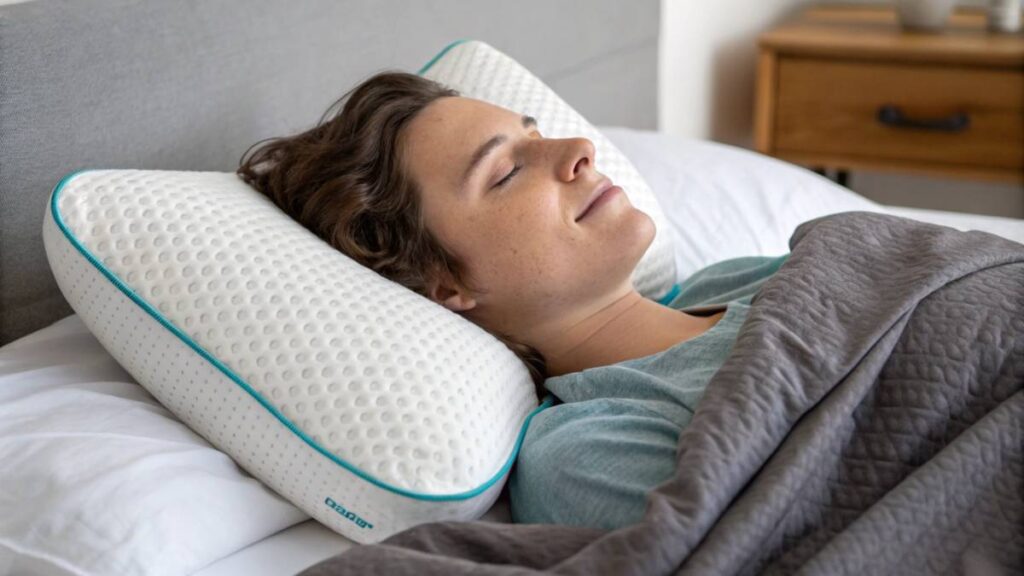
Back Sleeping
So, back sleeping. It sounds all nice and neutral but not quite for folks with sleep apnea. Your tongue and those squishy throat bits might just decide to kick back too, potentially getting all up in your airway.
Pros:
- Could help your back stay in line with a smart pillow choice.
- Really good for keeping acid reflux at bay.
Cons:
- Airway might get blocked more often.
- Snoring like a chainsaw, which could keep your partner tossing and turning.
| Aspect | Description |
|---|---|
| Increased Risk | Pretty high up there |
| Recommended For | Those without major apnea struggles |
Side Sleeping
Side sleeping’s kind of the golden child for sleep apnea warriors. It helps keep things clear so you can breathe easy and not sound like a freight train in the night, making both you and your partner happy campers.
Pros:
- Helps you breathe better.
- Cuts down snoring and apnea fits.
- Eases off the squeeze on your innards.
Cons:
- Might give your shoulder or hip something to complain about if your bedding’s not up to snuff.
- Can give you those crinkly face lines in the long haul.
| Aspect | Description |
|---|---|
| Increased Risk | Nice and low |
| Recommended For | Just about anyone with sleep apnea |
Stomach Sleeping
Stomach sleeping isn’t super popular, and it’s usually not the best bet if you’ve got sleep apnea. Sure, it might calm the snoring beast, but your neck and back might not be too thrilled.
Pros:
- Could hush the snoring for some folks.
- Might feel comfy for certain bodies out there.
Cons:
- Neck cramps are no joke.
- Might flatten your airway, making things worse for apnea.
| Aspect | Description |
|---|---|
| Increased Risk | Moderate to high zone |
| Recommended For | Hardly ever a good idea for apnea folks |
Picking the right sleep style is kind of essential for kicking those apnea symptoms in the butt and catching better Z’s. Trying different spots and snagging a supportive pillow could be the game-changer you need. For more tips on sleep apnea, like checking out symptoms and discovering causes, dive into more reading.
Adjusting Sleep Habits
Let’s chat about ways folks can tweak their sleep game for a better night’s rest, especially for those wrestling with sleep apnea. A couple of tricks up the ol’ sleeve include propping up that noggin’ and getting cozy with some pillow power to amp up comfort and help you breathe easy while catching them Zzz’s.
Elevating Your Head
Raising your head just a smidge during sleep can make a big difference in dealing with sleep apnea. It can ease up on those pesky airways, letting the breath flow with less hassle. Sleep like this could mean less midnight wheezing and more dreamy snoozing.
Check out a few perks of keeping your head up high:
| Perk | What it Does |
|---|---|
| Better Airflow | Keeps those sneaky airway blockages at bay. |
| Less Snoring | Lowers the vibes that turn sleep into a snore fest. |
| Added Comfort | Makes your sleep feel like a peaceful hug. |
To ramp up your head elevation, try getting an adjustable bed, snagging a wedge pillow, or doubling up on regular ones. Curious about more tricks? Take a peek at our natural sleep apnea remedies.
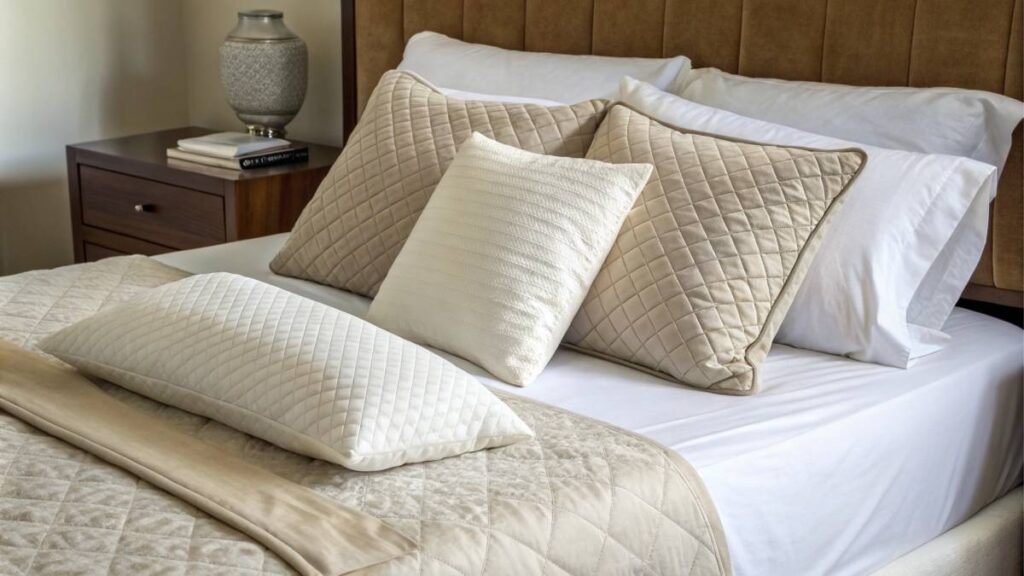
Using Pillows for Support
Strategic pillow positioning is like your sleep wingman, helping you land the primo snooze spot when dealing with sleep apnea. A smart pillow setup can kiss pressure on your neck and spine goodbye, making dreamland even cozier.
Here’s the lowdown on the pillow posse you want in your corner:
| Pillow Type | Good Vibes You Get |
|---|---|
| Wedge Pillows | Offers a nice slope to boost breathing. |
| Contoured Pillows | Cradles your neck and keeps the spine in line like yoga class. |
| Body Pillows | Perfect for curling up and conquering side sleeping, a real winner! |
Ensure your head, neck, and spine have their ducks in a row to skip the morning grumble. And partners of snore monsters? They’ll love a quiet night, too, with the right pillow setup. Need more juicy deets? Check out our piece on sleep apnea symptoms.
By tweaking these sleep tweaks, folks can inch closer to those golden hours of peaceful shut-eye and sidestep some of sleep apnea’s worst effects.

Lifestyle Changes for Better Sleep
Tweaking your daily habits can make a noticeable difference in how well you sleep, especially if you wrestle with sleep apnea. Let’s take a look at two game-changers: keeping your weight in check and steering clear of booze and big meals before hitting the hay.
Small adjustments in daily habits can lead to significant improvements in sleep health, especially for those battling sleep apnea.” – John Doe, Wellness Coach
Weight Management
Packing on extra pounds is often a big no-no for sleep apnea. Dropping a few pounds can do wonders for your breathing and might lessen those annoying sleep interruptions. You don’t even need to lose a ton. Even shedding a little weight can put you on the path to dreamland.
| Weight Loss Percentage | Potential Improvement in AHI Score |
|---|---|
| 5% | 26% |
| 10% | 50% |
| 15% | 75% |
So, what’s this AHI thing? It’s short for Apnea-Hypopnea Index and quite handy for figuring out how serious someone’s sleep apnea is. The lower the score, the nicer your night! If dropping pounds is on your to-do list, you can look into natural sleep apnea remedies for some handy tips on adopting a healthier lifestyle.
Avoiding Alcohol and Heavy Meals Before Bed
A nightcap may sound tempting, but alcohol can loosen up throat muscles a bit too much, making sleep apnea behave like an unwelcome guest. Folks dealing with this should try to dodge the drink, especially as snooze time approaches.
Think twice before diving into a massive dinner late at night. Heavy fare can bring on heartburn and mess up your sleep pattern. Munching something like a light snack a few hours before bedtime is usually the way to go.
| Timing | Recommended Practice |
|---|---|
| 2-3 Hours Before Bed | Light Snack |
| Less than 2 Hours Before Bed | Avoid Heavy Meals |
| Before Sleep | Limit Alcohol Consumption |
Switching up some of these aspects in your lifestyle can really improve your sleep and ease some of those pesky symptoms of sleep apnea. Want to know more? Check out articles like what causes sleep apnea for some extra info and tips.
Seeking Medical Advice
Getting a grip on sleep apnea means getting some help from a healthcare pro. If you’ve got the signs or your partner sounds like a lumberjack at night, it’s time to get checked out and see what can help.
Consultation with a Sleep Specialist
Seeing a sleep specialist is like having a roadmap to understand how severe your sleep apnea is. These pros might have you do an overnight stint in a sleep lab or give you a home sleep apnea test to keep tabs on your breathing and heart rate while you snooze.
During your chat, they’ll give you the scoop on the most restful positions to catch some Zs, all while keeping your symptoms at bay.
Here’s some of what they’ll cover during the consultation:
| Aspect | Description |
|---|---|
| Medical History Review | Diving into your health past and sleeping habits |
| Symptom Assessment | Checking out how often and just how bad your symptoms are |
| Diagnostic Testing | Suggesting tests to nail down what’s going on |
| Treatment Options | Looking at lifestyle changes, therapy, or gadgets |
Benefits of Professional Guidance
Grabbing some advice from a sleep pro has plenty of perks. They’ve got the know-how to dish out advice tailored just for you.
Here’s why you should chat with a specialist:
- Accurate Diagnosis: They know the difference between central and obstructive sleep apnea and can figure out what fits you best.
- Treatment Planning: They’re the pros at cooking up a plan that suits you, even brainstorming alternatives to CPAP if that’s not your jam.
- Monitoring Progress: Regular check-ins help tweak your treatment to how you’re feeling and if things are getting better.
- Education on Symptoms: Learning what sleep apnea symptoms to look out for could mean getting help faster.
- Associated Health Risks: Knowing the risks, like sleep apnea heart concerns, can help steer you toward prevention.
In short, seeing a sleep expert could be your golden ticket to tackling sleep apnea, opening doors to managing it way better.
Monitoring Sleep Quality In The Real World
Keeping an eye on how you snooze is like having a personalized sleep detective. For folks battling sleep apnea, this is key. Knowing how you sleep can help you spot trends, tweak treatments, and figure out the best way to hit the hay with ease.
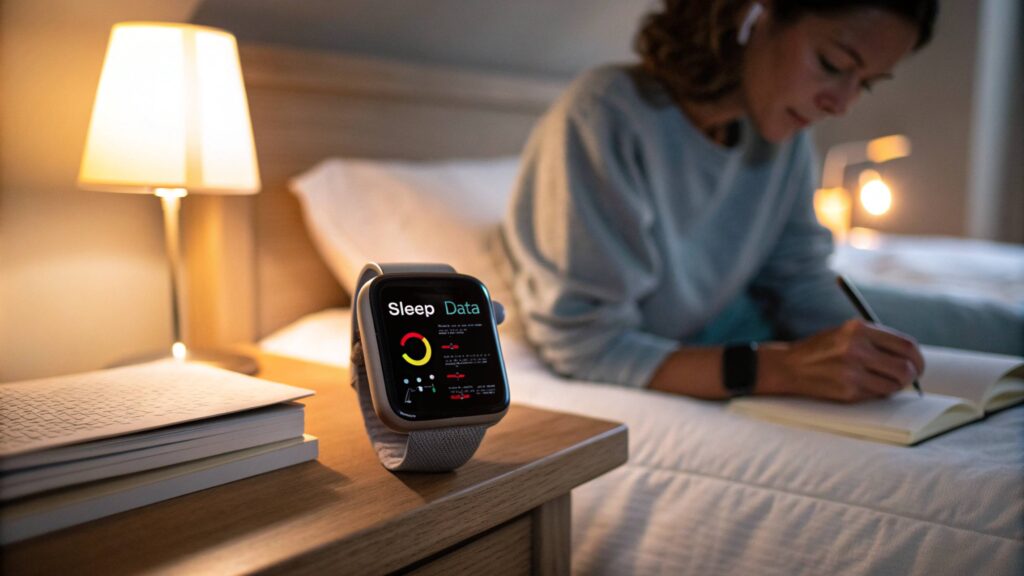
Gadgets For Tracking Shut-eye
There are some super neat gadgets out there to help you get the lowdown on your Z’s. These gizmos check out all sorts of stuff like how long you’re in dreamland, how often you wake up, and even your heartbeat. Many wrist gadgets and phone apps dish out handy info that can help keep your sleep apnea in check.
| The Gadget Gang | What It Can Do |
|---|---|
| Smartwatches | Keep tabs on your ticker, sleep cycle, and nudge you to rise. |
| Fitness Bands | Measure your snooze time and overall get-up-and-go. |
| Sleep Apps | Peek at sleep habits and toss out tips to sleep better. |
Peeking at all this info lets you connect the dots between your sleep habits and your apnea woes. It’s like having your own nighttime mastermind group!
Jot It Down: The Sleep Journal
Putting pen to paper in a sleep journal gives you a snapshot of any sleep apnea shenanigans and how your favorite sleep pose shakes up your rest. Here’s what you might include:
- Bedtime & Rise-and-shine time
- What the room’s like (too noisy? too toasty?)
- Your chosen snooze stance (on your back, side, or if you fancy, tummy-down)
- Did you snore the house down, or have apnea episodes?
- How you felt come morning (ready to conquer the day or dragging along?)
| Journal Date | Example Deets |
|---|---|
| Date | October 10, 2023 |
| Snooze Count | 7 hours |
| Sleep Spot | Left side |
| AHI Score | 5 |
| Morning Mood | Drained, carrying a head-thumper |
Jotting stuff down regularly helps you see how different poses change up your apnea symptoms. All of this detective work can go to your doctor buddies to help you find the perfect snooze strategy. For more on cracking the sleep apnea mystery, check out our pieces on sleep apnea symptoms and what causes sleep apnea.
Main Tips
- Prioritize Side Sleeping: This position helps keep airways open and reduces apnea episodes.
- Invest in Quality Pillows: Choose wedge, contoured, or body pillows to support your neck and spine.
- Maintain a Healthy Weight: Even a modest weight loss can significantly improve sleep apnea symptoms.
- Avoid Alcohol and Heavy Meals Before Bed: These can relax throat muscles and disrupt sleep patterns.
- Use Sleep Tracking Gadgets: Monitor your sleep quality to identify and address issues promptly.
- Keep a Sleep Journal: Recording your sleep habits can help you recognize patterns and make necessary adjustments.
- Consult a Sleep Specialist: Professional guidance can provide personalized treatment plans for effective management.
Final Thoughts
Navigating the challenges of sleep apnea requires a blend of informed choices and proactive strategies. By prioritizing the right sleep positions, investing in quality pillows, and embracing lifestyle enhancements, you pave the way for more restful and uninterrupted nights. Additionally, leveraging technology to monitor your sleep patterns and seeking expert advice can further optimize your sleep health. Remember, each small step contributes to significant improvements, turning the elusive quest for quality sleep into a manageable and rewarding journey. Take control of your nights today and wake up to brighter, more energized mornings!
Conclusion
Achieving restful sleep amidst sleep apnea doesn’t have to be an elusive dream. By embracing side sleeping, investing in the right pillows, and making mindful lifestyle changes, you can significantly alleviate symptoms and enhance your nightly rest. Understanding the intricacies of sleep apnea and its impact on your health empowers you to take proactive steps towards better sleep hygiene. Additionally, leveraging modern gadgets and maintaining a sleep journal provide valuable insights to fine-tune your sleep strategies. Remember, seeking professional guidance can tailor solutions to your unique needs, ensuring a harmonious balance between user experience and optimal health. Transform your sleep routine today and wake up refreshed, ready to seize the day!
FAQs
What is the best sleep position for sleep apnea?
Side sleeping is the most recommended position as it helps keep airways open, reducing snoring and apnea episodes.
Can changing my pillow help with sleep apnea?
Absolutely. Using wedge, contoured, or body pillows can provide better support and maintain proper airway alignment.
How does weight affect sleep apnea?
Excess weight can increase the risk of airway obstruction, worsening sleep apnea symptoms. Weight management can significantly improve breathing during sleep.
Are there alternatives to CPAP machines for treating sleep apnea?
Yes, options include lifestyle changes, oral appliances, positional therapy, and in some cases, surgery. Consulting a sleep specialist can help determine the best treatment.
How can I monitor my sleep quality at home?
Using smartwatches, fitness bands, sleep apps, and maintaining a sleep journal are effective ways to track and improve your sleep quality.

